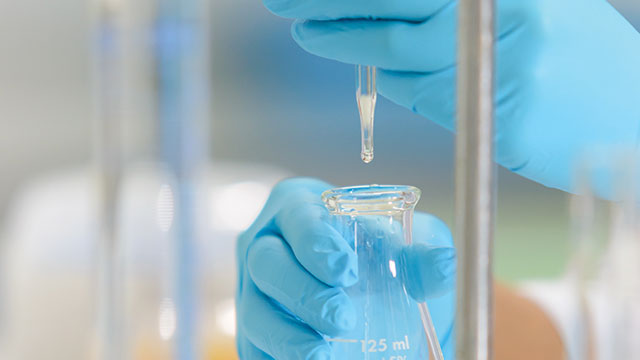Adding Automation to Titration
Turning a tedious process into a highly accurate and efficient one

To determine the concentration of an analyte, scientists often use titration. When working with many samples, the process can become tedious and less accurate without careful methods. Automation can solve those challenges. “Virtually any titration can be automated,” says Brian Kirk, head of lab marketing and business development at Mettler Toledo (Columbus, OH).
Automated titration is not a new technology. “Even though auto titration has been commercially available for more than 70 years, it’s still used in virtually every market that uses scientific tools to control quality,” says Jeff Tompkins, national sales manager for titrators at Hanna Instruments (Woonsocket, RI).
Even one titration takes time. A typical test takes about four to eight minutes, says Mike Nariman, president of AB Controls (Irvine, CA). “In addition, samples need to be prepared in multiple steps; they might need to be crushed, put in vials, sealed, opened at the time of the test, weighed, and presented to the titrator.”
One of the most popular titration techniques is the Karl Fischer method, which is the measurement of water content. Techniques that measure acidity, basicity, and salt content are also very common. “If there’s an analyte that reacts rapidly with a known titrant and there’s an electrode that can sense the reaction occurring, titration can be used.” Tompkins explains.
As Marv Kaiser, global product manager for electrochemistry at Cole-Parmer (Vernon Hills, IL), points out, the Karl Fischer method provides “several practical advantages over other methods of water-content determinations, such as speed, accuracy, and flexibility.” Karl Fischer titrators are often used with liquids, but they can be modified to accommodate gases and solids.
At the University of California, Irvine, Joe Rinehart, associate professor of anesthesiology and perioperative care, and his colleagues developed an automated system to titrate vasopressor infusions to control blood pressure. “The benefit of automating infusions is the same benefit humans generally derive from any form of automation: better target control with less need for human intervention, reduced risk of bias in implementation, and better adherence to protocols,” Rinehart explains. Edwards Lifesciences (Irvine, CA) licensed the technology developed by Rinehart and his colleagues and incorporated it into a monitoring platform. As Rinehart’s work shows, advances in automating titration can change health care.
Extensive selections
The first question is whether automated titration is the best choice for a specific application. To decide, Nariman asks how much time it will save compared to the manual process. With a high number of samples, the time difference can become huge. “An automated titration system allows operators to present multiple samples to a robotic system and walk away,” Nariman explains.
An automated titration system, according to Nariman, “is basically a system with the following subsystems: autosampler, balance, capping/uncapping, titrator, and automated washing of titration vessel.”
Once a lab decides on automation, the scientist is faced with a wide selection of instruments and options. “There are many different types of sensors and titrants that can be used in various combinations to solve many analytical measurement challenges,” Kirk explains.
To aid in the selection process, Tompkins makes two suggestions. “First, the quality of the titrant dispensing system, or burette, needs to be evaluated, and the other critical parameter is the electrode.” The electrode includes an indicator for the analyte being measured and a reference system that is specific to the sample matrix. “Both elements need to be proper to ensure accuracy of results and electrode life,” Tompkins says.
Some user-based features should also be considered. “The top feature to consider is ease of use,” Kirk says. “With virtually everything in the lab becoming automated, it is important that the user interface be easily mastered by the users of the equipment.”
Kaiser agrees. To make a platform easy to use, he recommends several features, including an intuitive touchscreen menu for easy setup and operation, preprogrammed methods, a simple apps-based user interface for easy operation, data-logging capabilities and software to easily transfer data to a computer, a built-in printer, and diagnostic tools to assist with common issues and avoid down time.
Maintaining performance
To ensure accuracy from automated titration, an instrument requires maintenance, but that’s not a big problem. Overall, the titrator and balance need to be calibrated regularly, and some of the parts require individual care. “The primary maintenance issue for an automated titrator is the sensor—typically an electrode,” Kirk notes. “Most sensors have a limited life span, and proper care and maintenance [are] critical to getting the most out of the titrator.”
In some cases, the electrode even requires daily care. With careful attention to vendor recommendations on electrode care, though, Tompkins says accurate results and long life can be attained. He also notes that electrodes are commonly mishandled, but scientists can extend the life and improve the accuracy of automated titration by following electrode-care guidelines.
Depending on what is used as the titrant, the burette can take a beating. To extend the burette’s life, clean it regularly. As Tompkins says, “When it comes to maintenance, it’s important to care for your burette, particularly if you’re using concentrated titrants and have a demanding work environment.” He adds, “This is normally done annually but can be more frequent in some cases.”
Wearable parts—such as the piston, burette, and stopcock—also require replacement, but the frequency depends on use.
Automated titrators can be used in many ways, and scientists need to make many decisions in order to select the best platforms with the most appropriate parts and features. Making the right purchase, however, is just the start, because proper use and maintenance matter too. By combining smart shopping steps and sound operating procedures, scientists can turn a tedious process into a highly accurate and efficient one.
For additional resources on titrators, including useful articles and a list of manufacturers, visit www.labmanager.com/titrators
